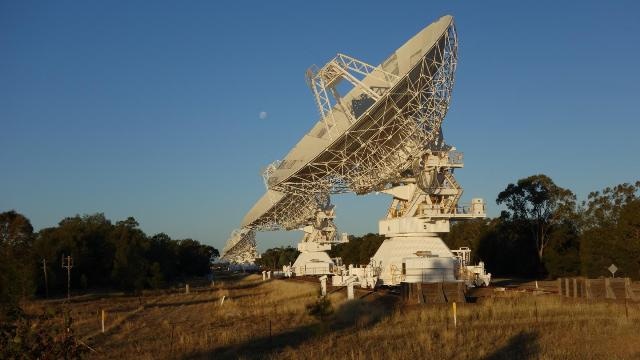Jul 4 2016
Last week, a team of Australian researchers successfully completed ‘Astronomical Verification’ of a critical sub-system of the Square Kilometre Array (SKA)—the forthcoming radio telescope that will be the largest and most sensitive on Earth.
 This image shows Compact Array antennas at sunset. (Credit: Sascha Schediwy)
This image shows Compact Array antennas at sunset. (Credit: Sascha Schediwy)
The equipment in question, built in partnership with SKA’s Signal and Data Transport consortium, was a prototype of the SKA telescope’s ‘frequency synchronisation system’—a system that allows the telescope to collect extremely sensitive data even though its individual antennas are separated by hundreds of kilometres.
The researchers from the International Centre for Radio Astronomy Research, The University of Western Australia School of Physics and CSIRO Astronomy and Space Science tested their prototype equipment at CSIRO’s Australia Telescope Compact Array (ATCA) in Narrabri, NSW over a two-week period.
“We found that it performed between 10 and 100 times better than the requirement for the SKA,” said lead designer Dr Sascha Schediwy from ICRAR-Physics at UWA.
“The SKA telescope is designed to be synchronised using ultra-stable frequency signals that are transmitted on optical fibre from a centrally-located atomic clock, to each of the telescope’s hundreds of individual antennas.”
“As mechanical stresses and thermal changes acting on the fibre degrade the stability of the transmitted signals, the SKA requires an active frequency synchronisation system to maintain coherence across the array.”
UWA’s prototype SKA frequency synchronisation system continuously measures the changes in the fibre link and applies a correction in real-time, reducing fluctuations to no more than one part in ten trillion over a 1-second period.
“A clock relying on a signal of that stability would only gain or lose a second after three million years—such extremely precise synchronisation is necessary for radio telescope arrays like the SKA to function,” said Dr Schediwy.
Australian SKA Project Director, Mr David Luchetti, said the extreme accuracy of this technology could have all sorts of applications beyond discovering stars and galaxies from the early Universe.
“Astronomy is constantly pushing the boundaries in fields like precision timing, imaging and big data management, leading to new technologies like GPS location systems and more advanced medical imaging,” said Mr Luchetti.
“At the time of invention, we often don’t fully appreciate the extent to which these technologies can change lives and boost the economy.”
Dr Schediwy said CSIRO’s Compact Array is the ideal astronomical facility to conduct SKA astronomical verification trials.
“Each of its six antennas is equipped with two independent but identical receivers. The team could therefore connect UWA’s SKA synchronisation system to one set of receivers, while the other set remained unaltered.”
“This unique set-up enabled simultaneous observation of a reference galaxy in the sky using both the standard Compact Array reference system and UWA’s SKA synchronisation system, so a comparison of the astronomical data can be made to see if there are any differences between the new system and the established technology”
“Subtracting the two observations resulted in a direct astronomical measurement of the stability performance of our SKA synchronisation system. We also independently compared those results to a second measurement of the frequency transfer stability made simultaneously using standard metrology methods and equipment.”
“This success comes at an excellent time for the SKA project and our design, as the final decision on technology for the frequency stabilisation system will be made in the coming months.”